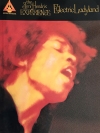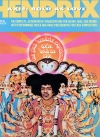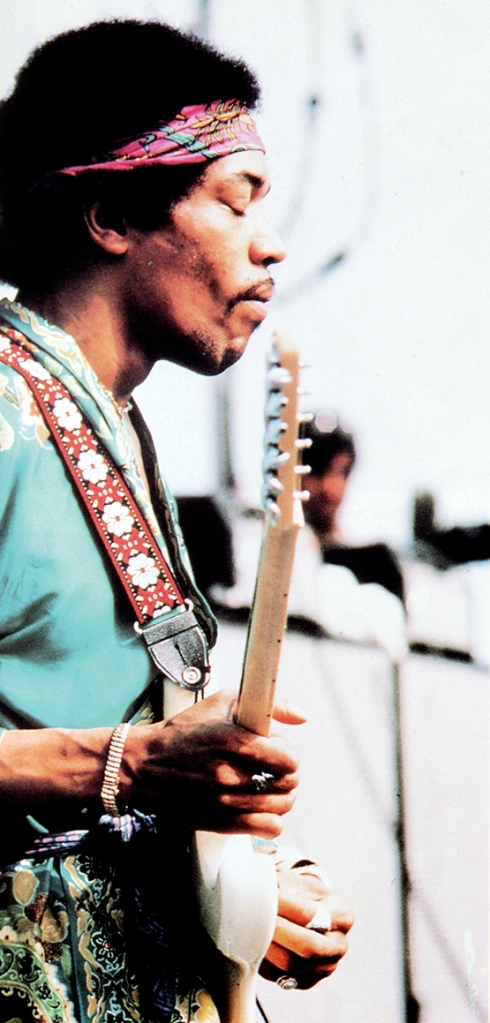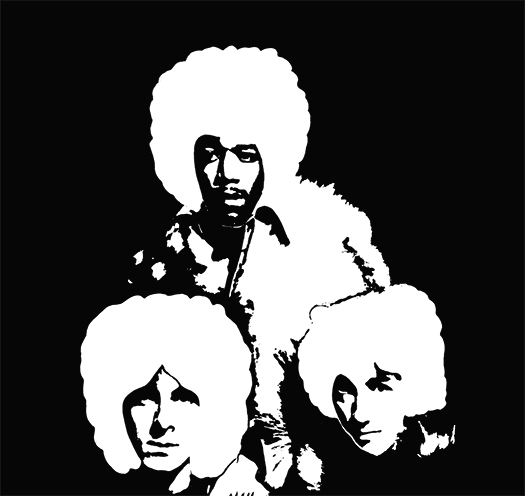How to sound like Jimi Hendrix? That’s a loaded question and one people have been trying to answer for many years, obviously. I feel I am qualified to talk about it since I have played a bunch of Jimi over the years in various settings. There are a few tips and tricks I can offer and the first is always try to watch someone play live or video. Nothing beats seeing Jimi or one of the true masters play his stuff and there’s plenty to be found online. Definitely start there.
play the blues
Before one dives into the details, probably the most important and obvious thing to realize is that Jimi achieved his excellent sound and style on guitar by learning and playing blues, early rock and roll/rhythm and blues guitar. Take apart almost every song, every jam that features Jimi Hendrix and you will find the structure and sound of the blues underneath, no matter how FAR OUT the song is. Blues playing is primarily intuitive and feel-based. Jimi’s knowledge of music theory, best described by Miles Davis is his autobiography, was limited, but his ear was finely developed and he had a great musician’s instinct. According to Miles (via Jimi Hendrix: Electric Gypsy page 399): “When Miles attempted to explain musical theory, Jimi just looked blank, but once Miles played the piece, however complex it was, Jimi picked it up immediately.” Having a background in the blues enables you to comfortably navigate many styles of music. If you can’t play a half decent blues solo or are not happy with your knowledge of the blues and pentatonic scales and blues phrasing, work on that first. Definitely make sure you can navigate the fretboard in all positions. You can base the above scales or arpeggios off of the chords you are playing. Many of Jimi’s best riffs and solos come from this way of doing things. Also, make sure your bends, slurs and hammer-ons/pull-offs are as accurate and clean as you can make them. These techniques must be practiced slowly and carefully to get them right. There are many blues guitar lessons on YouTube. Look around and find ones that will help you with areas you are having trouble and practice until you have it down.
spice it up with some jazz
Though Jimi wasn’t thought of as a jazz musician by most people of his time, he was influenced very heavily by jazz icons like Wes Montgomery and, especially, Rahsaan Roland Kirk, who was instrumental in Jimi’s approach to sound collages like Third Stone From the Sun. Jazz does figure in some of the rhythmic patterns that Mitch Mitchell developed and used in songs like Manic Depression, the middle of If 6 Was 9 and very obviously the brush work (actually suggested by Noel Redding) in Up From the Skies. (Mitch had actually played in jazz bands prior to joining The Experience). Jimi rarely played the standard power chord shapes, opting instead for variations that allowed him to use his thumb to cover the bass notes. He also used very jazzy 6, 9, maj, and sus chords on songs like If 6 Was 9, Third Stone From the Sun, Love or Confusion, Angel and many others. Jimi also regularly used partial chords as runs or lead lines. This chord melody type of playing is common in jazz and is also used in rhythm and blues/Stax playing as well. There are many jazz/rock lessons as well as chord melody lessons on YouTube. Not only will this knowledge help with Jimi Hendrix tunes, but it will also expand other areas of your playing.
technical stuff
Jimi’s technique, which was developed from constant playing and a whole lot of roadwork with bands like the Isley Brothers and Little Richard, made use primarily of Fender instruments, Stratocasters especially. Jimi would restring a right-handed guitar and play it lefty, which meant that the volume and tone controls, pickup switch and whammy bar were in a different position than would be typical for a player no matter they were right or left handed (if they were playing the appropriate guitar). According to the book Scuse Me While I Kiss the Sky, he would bend the whammy arms by hand to allow him “to tap each string with the bar” (?) but the book Jimi Hendrix: Electric Gypsy disputes this saying he bent the arms to allow the bar to line up with the high E string. I wouldn’t be surprised if both of these theories are wrong and he bent the arms to allow for further depression of the tremelo unit, resulting in much wider and deeper bends. From reading guitar magazines I know that Jimi favored using 4 springs for the whammy unit and used custom light strings. According to Jimi Hendrix: Electric Gypsy from September of 1966 through June of 1967 Jimi played tuned to regular concert C or E, if you prefer. (This time period would’ve included the recording of Are You Experienced?) The sessions for Experienced and the 2nd album, Axis: Bold as Love were almost back-to-back but most of the Axis album is tuned to Eb. From hereon Jimi would tune down (sometimes as low as D) and while this did allow for a “heavier”, darker guitar tone and ease of string bending, the primary reason was it was “less strain on Jimi’s voice”. He favored Marshall amps and turned everything way up, full blast! His outstanding control of his instrument and his ability to turn the sounds, noises and feedback into either vocal-quality sounds, sound effects or music was legendary (The Star Spangled Banner, Third Stones From the Sun, I Don’t Live Today). Randy Hansen, Jeff Beck, Eric Johnson and Stevie Ray Vaughan have all approached the level that Jimi had with this kind of manipulation of the instrument. He would frequently introduce himself to the audience as playing “public saxophone” and I think this illustrates that he looked at the guitar as “more than a guitar”, primarily dealt in SOUND more than TECHNIQUE or NOTES and was inspired and influenced by much more than other guitar music. Unfortunately there is no substitute for constant tweaking of one’s gear and sound to be able to replicate either Jimi’s sounds or the ones you hear in your head. Listening to and trying to replicate sounds that aren’t “music” can also broaden your approach. A major thing to understand is that these components are never the same in different rooms or situations. A player must constantly readjust as the gig goes along. Eric Johnson does this all the time. Watch him closely in these videos.
effects
While Jimi certainly made use of many different effects over the years, I’m not one of those people that believes you need to have expensive or even authentic pedals to get a sound that will reproduce a Jimi number well. I’ve certainly done without. All of those pedals are available though if you wish to go that route. Back in the late 80s I was at a jam in Brooklyn and after covering All Along the Watchtower 3 guys who had been hanging out in the lobby, including the guy who was running the studio came in and looked at my pedals. All I had was a Tube Screamer, an MXR Envelope Filter (for the wah sound) and a Boss digital delay. Without saying a word they looked at me, looked at the pedals, shook their heads and walked out. I had certainly done my homework on the solo parts of Watchtower and could play it well. I had also found some settings that really approximated the sound of the original and that night hit it perfectly right. I had a Crybaby wah-wah but did not always carry it around on the subway so that’s why I had the envelope filter instead. Worked out just fine. You would be amazed how much your hands and attitude affect how you sound. I was reading a discussion on Gearslutz the other day from people who were talking about recreating the sound of Van Halen 1. I know, guitar players can be geeks, nerds, whatever and just like to think and talk about different equipment, but you could easily sink $50,000 into a project like that, have all of the guitar and studio equipment that may or may not have been used back in 1978 and come up lacking, so keep that in mind.
putting it all together
A band I was in for a few years covered Love or Confusion live many times. By this time I no longer used a distortion pedal. I had a Mesa Boogie head and two 4×12 cabinets and just played loud using the gain from the amp. I also used a Phase 90 and an MXR Flanger and sometimes the Crybaby Wah. I never worried about playing the solo exact (and never do-just go for it!). The sound IS the thing. If you play in tune and in time and have the sound of this music (or any music) you are more than halfway there. I liked to concentrate on how the chords rang against the rhythm and the overtones at the end of each verse (and the end of the song). Eric Johnson covers this song nicely. I remember EJ said in an interview that some of the sounds Jimi got on those last stop chords reminded him of a vacuum cleaner. That’s why I spent a lot of time coming up with slightly different fingerings every time the G chords come around. I was always amazed how those parts sounded too! How did he do that? Sometimes the right amount of fuzz, vibrato and open-string overtones produced exactly what I was going for. The trick with these sus chords is to get that major/minor ambivalence thing between the strings you fret versus the strings that are ringing open. That’s how some of those cool combinations happen. I also tried do what Eric does — actually meld both of Jimi’s guitar tracks into 1! Good Times!
instruction
 In the old days these books were like the best thing, and in some ways still are. Meticulously notated for guitar, bass and drums — your whole band can look over the music and get down. You still have to bring the feel in for a lot of what you will be trying to do, but that’s where the fun is. Just like what I was talking about in the last paragraph. All of these books have tab and performance notes and I used them a bunch back in the day for songs that I hadn’t been able to pick up just by listening. All of the transcriptions were done by Andy Aledort and the performance notes and general supervision was done by
In the old days these books were like the best thing, and in some ways still are. Meticulously notated for guitar, bass and drums — your whole band can look over the music and get down. You still have to bring the feel in for a lot of what you will be trying to do, but that’s where the fun is. Just like what I was talking about in the last paragraph. All of these books have tab and performance notes and I used them a bunch back in the day for songs that I hadn’t been able to pick up just by listening. All of the transcriptions were done by Andy Aledort and the performance notes and general supervision was done by  Dave Whitehill and they are both giants in the guitar biz. Usually associated with Guitar World Magazine, I’m sure their names are familiar to anyone who has been around the biz for awhile. Because they are are total pros you know there aren’t any mistakes. While I regularly find mistakes in tabs I find online or in some of the YouTube tutorials, I have never encountered one in these books. They are still very affordable and I would recommend if you are looking for accurate reproductions of Jimi’s music.
Dave Whitehill and they are both giants in the guitar biz. Usually associated with Guitar World Magazine, I’m sure their names are familiar to anyone who has been around the biz for awhile. Because they are are total pros you know there aren’t any mistakes. While I regularly find mistakes in tabs I find online or in some of the YouTube tutorials, I have never encountered one in these books. They are still very affordable and I would recommend if you are looking for accurate reproductions of Jimi’s music.
instruction II
For those who don’t want to go the book route, there are, of course, many online resources for Jimi Hendrix material. As I said in the last paragraph, however, be careful that it is a good tab or lesson or you’ll be wasting your time. I recommend watching any live Jimi you can find. Then check out Randy Hansen(!), Stevie Ray Vaughan and Eric Johnson, or some of the stuff from the Experience Hendrix tour. For lessons, here’s a series that walks you through most of the songs on the first side of Are You Experienced?. Here’s Joe Satriani showing how he plays like Jimi and here’s an interesting video on getting a sound in the vein of Jimi. YouTube is FULL of many interesting videos on playing like Jimi Hendrix so strap in, strap on the guitar and get cracking! You’ll be wowing your friends with stunning versions of his best songs in no time at all!

